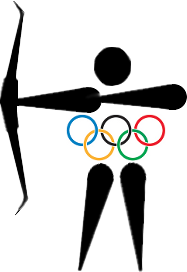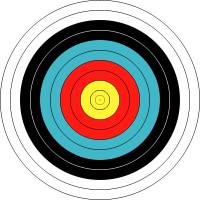
Olympic Archery
Olympic Competition History

Archery was contested at the Summer Olympic games for the first time in 1900, where four countries competed. It was contested again in 1904, 1908 and next in 1920. In those early years, each host country used its own rules and included varying disciplines. The 1904 US Olympic games in St. Louis only saw competitors from the USA competing in the 5 archery events of that year.
There were no archery events in the Olympics after 1920 until 1972 in Munich, which is the start of the modern Olympic archery games. That games had just the men's and woman's individual competitions shot over a double FITA round. In 1988 the format changed to a Grand FITA Round and that year also saw the first team event competitions in addition to the men's and women's individual events.
In 1992 the new Olympic Format was introduced, which was then simplified in 2008 to make it more interesting for the spectators and for TV coverage. The current Olympic format is outlined below.
Qualification into the Olympics
Currently there are 4 archery disciplines, Men's individual, Women's individual, Men's team and Woman's team. Teams are made up of three competitors. Unlike many sports, entry into the games is not allocated to individuals. Instead, the majority of the 64 available places for each individual (men/woman) competition is allocated to National Olympic Committees (NOC). Each NOC can have up to a maximum of three competitors in the games. The modern Olympic format consists of 64 individual places and are allocated like this:
- (3) The host nation's NOC automatically gets 3 places.
- (24) The NOC for the top 8 countries in the previous World Target Competition get 3 places each. If that includes the host nation, then the 9th placed country's NOC is allocated those 3 places.
- (19) The highest ranked archers in the world (not already selected) are allocated next, whilst ensuring that no NOC will be allocated more than 3 places in total, until 19 places have been allocated.
- (15) The five Olympic continents have 3 places each and hold competitions to fill those places.
- (3) A Tripartite Commission allocates the final 3 places on a 'By invitation' basis to the next three archers they believe worthy of entering the games, but not otherwise selected.
Team competition
Any NOC that gains 3 individual places as above, is then able to enter their individual team members into the Team competition. They must be the same three athletes that were in the individual competition itself. (Rules exist to cover injury etc., but this is intended as a brief overview, not a full description of all the rules to the lowest detail.)
Olympic Format Competition
The only format shot in the Olympics is recurve. Each discipline is similar, in shooting the Olympic distance of 70M (both men and women) at a 122cm metric-style 10-point target face.

See the FITA Scoring page for a fuller description of this target scoring system.
For the individual competitions, all archers initially shoot a 'Ranking round' consisting of twelve ends of six arrows (72 in total) and they are then ranked according to their score. No one is eliminated at this stage. The event moves on to the 'Final elimination rounds'. In the first of these rounds the top ranked archer is matched against the bottom ranked archer and so on in a 'match'. Since 2008 the format was made simpler than in previous Olympic games, as all matches now follow the same format of just 12 arrows, with each archer shooting alternately (the lower ranking archer shooting first). Each archer must shoot within 40 seconds. If there is a tie in score after 12 arrows, a sudden-death arrow is shot. If there is still a tie, a second sudden death arrow is shot and then a third is shot if required. If there is still a tie after 3 sudden death arrows, the winner is decided by whoever's third arrow is closest to the centre. The winner goes through to the next round and the looser is eliminated, except for the two losers of the semi-final matches who go on to shoot a match for third place honours.
The team competitions follow the individual events, and the combined score of the three archers from the Ranking round in the individual competition (above) is used to rank the teams. The team qualification process (above) usually means there are not exactly 16 teams, in which case the highest ranking team(s) will get a bye into the second elimination round. The teams shoot 'matches' based on rank, where each match is made up of 24 arrows over four ends of six arrows each. Each archer shoots two arrows per end. Each team shoots one arrow alternatively and the archer must shoot within 40 seconds. If there is a tie in scores after 24 arrows, each archer shoots one more arrow (each team in turn) and the highest team total wins. If there is still a tie, the arrow closest to the centre on each team are compared to award the winning team. The semi-final losers shoot a match to award the third place honours as in the individual competition.